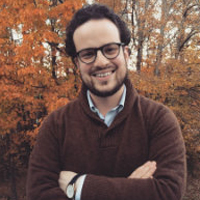Griffin School Partnerships enrich WJCC students
An adolescent girl seeking advice on how to ask a boy for a date once approached Casey Frederick, a member of the Griffin School Partnerships Board and a tutor at Berkeley Middle School.
Whatever Frederick said worked, though one week later the girl was back. “Now I need to break up with him,” she said. Now what do you say?
Clearly, William & Mary’s Griffin School Partnerships program covers a multitude of areas.
So is Frederick ‘19 comfortable giving romantic advice?
“To middle schoolers, yes,” he said, laughing, “but that’s about it.”
Nearing the end of its first year, the Griffin School Partnerships Program has matched 162 Tribe student tutors and mentors with children from Matthew Whaley, Clara Byrd Baker and James River elementary schools; Toano, Lois S. Hornsby and Berkeley middle schools and Warhill High School.
Student mentors work at the elementary and middle school level, are engaged in one-on-one relationships that span the entire year and are focused on academic, social and emotional development. Their work takes place exclusively at the school, with students the school has identified as potentially benefiting from more personalized attention.
“It’s all about creating significant, supportive relationships,” said mentor and school coordinator Mary Kate Maher ‘19, who works at James River Elementary. “We visit with our students once a week and give them the individual attention they may not be getting at home or in their classrooms. The goal is to ensure that our mentees feel supported and heard.”
Meanwhile, student tutors work in groups and focus mostly on academics. They can also participate in what is called an “after-school enrichment program,” post-homework or study time spent outside, in the gym or the cafeteria where everyone plays games or talks about their day – or even asks for relationship advice.
Frederick coached tennis in his hometown Philadelphia for five years, working with children from third to sixth grade.
“When I came to William & Mary, doing this seemed like a natural extension,” Frederick said. “Watching them grow and shine is one of the most rewarding experiences I’ve ever had.”
Joseph Boselovic ’11, coordinator of education programs for the Office of Community Engagement at William & Mary, works closely with contacts at each school, sometimes the principal or sometimes a guidance counselor, to pair students with tutors or mentors. But he also meets a couple of times a semester with Felicia Highland, who is the director for family community engagement and public relations in the Williamsburg James City County district.
“We like to have partnerships with individual schools, so we can meet their needs and general requirements,” said Boselovic, who clearly has an eye on expanding the program. “But our partnership is more broadly with the district. That’s nice, too, talking about extending the mission. They’re good about working with us on what’s pertinent to all seven, as well as all the schools we might want to work with in the future.”
The W&M mentors and tutors don’t just walk into their classrooms unprepared. All undergo baseline training on how to work with schools meaningfully, how to work with students, how to work with teachers and how to handle themselves in that kind of setting.
They are presented with scenarios and strategies, such as ways to handle a student they’re supposed to tutor in math but who doesn’t want to do the homework.
“We talk about relationship building,” Boselovic said. “They receive a presentation from two people from family services in James City County about how to recognize the signs of child abuse or other potential issues.”
Every semester, each volunteer has to attend at least one of three training sessions.
That can lead to some inspired teaching methods.
Luc Nguyen ’18, the school coordinator for Warhill High, was tutoring a student struggling to grasp what a pentagon looked like. “Let’s work on it,” Nguyen said.
So he dropped his pen and asked the student to pick it up. When he did, Nguyen gave him a high five. He dropped it again. Another high five. And again. Another high five.
After the fifth drop and high five, the student got it. Pentagon. Five sides.
“The students seems to enjoy our presence in the classroom,” Nguyen said. “The students ask us about college – the application process, dorm life, extracurricular activities, etc. This partnership allows students to begin thinking about college as a viable and desirable option.”
Sarah Horan ’18, a business and psychology major, was involved in the program when it was known as College Partnership for Kids. She has worked at all grade levels serviced, this year in a kindergarten classroom at Matthew Whaley.
“In kindergarten, they don’t necessarily remember you if you’re only there once a week for a few hours,” she said. “It takes more time to forge that relationship. Middle school students are more perceptive, but a bit more guarded with regards to whom they let into their life in terms of trust and understanding.
“There are positives to both, seeing them grow and have their own identity over time. It’s really interesting to hear about their passions, what they’re interested in and to see them develop their sense of self.”
















